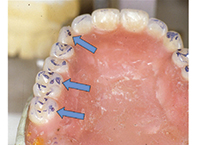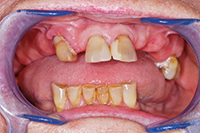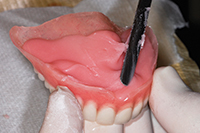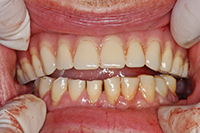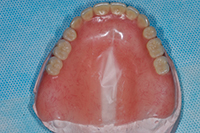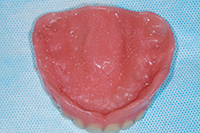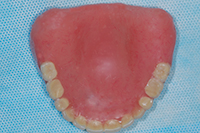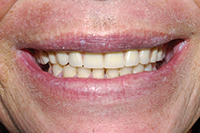Over the years, as general dentists, we will see many patients in our offices who have been treated with different types of implant restorations.1 We may or may not have had the opportunity to plan the prosthesis that the patient is wearing, but we have to learn how to manage a variety of cases. In situations where the patient feels uncomfortable or is unable to function properly, we need to be able to determine if we can provide an appropriate solution.2
CASE REPORT
Diagnosis and Treatment Planning
Our patient was previously treated in 2001 with a maxillary implant-retained tissue-supported partial overdenture, extending from the maxillary right first molar to the maxillary left first premolar3 (Figure 1). The overdenture was retained by 4 o-ring abutments on implants placed in the anterior maxilla (Figure 2). This particular design created 2 posterior cantilevers bilaterally in the acrylic partial overdenture.4,5 The existing acrylic material lacked adequate thickness and strength due to the limited interarch space available, providing another factor that made this partial overdenture prone to fracture.6 Lastly, all the implants were placed in positions that did not correctly fit the position of natural teeth, emerging instead between the teeth interproximally (Figure 3).
 |  |
| Figure 1. Existing o-ring partial overdenture. | Figure 2. O-ring abutments in anterior maxilla. |
 |  |
| Figure 3. Implants, previously placed, emerged interproximally in relation to the natural tooth positions. | Figure 4. Broken partial overdenture. |
Originally, the patient had presented to our office with one of several broken maxillary o-ring partial overdentures, requesting a repair (Figure 4). We were able to do the repair, and we also gave the patient a good amount of information about alternative treatment options. We explained the reasons why her present situation would continue to give her the problems that she had been struggling with for years. When we saw her again the following year, she had made the decision to proceed with the additional work needed to improve her dental condition.
Initial records consisted of a standard intra- and extraoral photographic series, and a panoramic radiograph (Figure 5) supplemented by several periapical radiographs. Study models were mounted in centric relation using a stick-bite registration and face-bow record. This information allowed us to properly assess the patient’s clinical situation, and to design a treatment plan that would result in a comfortable, functional, and durable prosthesis.
The following existing conditions were noted at the time of the initial examination:
- Semi-edentulous maxillary arch against mandibular natural teeth (only Nos. 2, 13, 14, and 15 remain).
- Interarch space of 8 to 9 mm when patient is in occlusion.
- Supra-erupted maxillary molars restored with PFMs.
- A one-tooth distal cantilever on the left, and a 2-tooth distal cantilever on right.
- Slight labial placement and angle of 2 implants on right.
- Sinus problems, with a history of sinus surgery.
- Needs replacement of several crown and bridge, and composite restorations.
There were no clinical signs of temporomandibular dysfunction and her medical history was noncontributory.
A fixed partial denture was proposed that would include sinus grafting and the addition of 2 or 3 more implants, after an ear, nose, and throat evaluation and treatment of the sinuses. However, the patient refused to proceed with this plan, so a compromised plan was agreed upon. She agreed to have one additional implant placed (as far distally as the anterior wall of the sinus would permit without encroaching upon it) in order to reduce the length of the distal cantilever on the right, yet still be able to give her a fixed prosthesis.7 Since a fixed prosthesis requires less interarch distance than a removable one, this measurement was no longer a concern; however, the emergence of the 4 anterior implants still presented a problem. It was determined that the highest extent of her smile-line was low enough that she did not have any gingival exposure, and the patient was amenable to having the incorrect emergence masked with pink porcelain.8
 |  |
| Figure 5. Panoramic radiograph. | Figure 6. Additional implant, close to anterior wall of the sinus. |
 |
 |
| Figure 7. Radiograph of pick-up impression copings. | Figure 8. Face-bow mounting. |
 |
| Figure 9. Abutment seating, verified with bitewing radiographs. |
One of the concerns in treating the case was the identification of the implants and finding the necessary components to make the change in design. The implants were identified (Zimmer Spline 3.25 cylinders), and we were glad to learn that all the parts that would be needed to restore the case were still available.
A Synopsis of the Clinical Treatment and Laboratory Work
The patient received one additional implant (Zimmer Screw-vent 3.4 x 11.5) close to the right anterior sinus wall (Figure 6), and after a 5-month waiting period for osseointegration, the case was ready to begin the prosthetic phase of treatment.
The impression copings of the Spline system were much wider than the 3.25 prosthetic platform of the implants, requiring a local anesthetic. They were pick-up copings (Figure 8) and required an open-tray impression to compensate for the divergent angles.9,10 The impression was taken with a vinyl polysiloxane (VPS) material (Genie VPS Impression Material [Sultan Healthcare]) using a regular body/light body technique.11
 |
| Figure 10. Radiographs of the completed case. |
 |
| Figure 11. The new completed maxillary fixed partial denture. |
In the dental laboratory, a soft-tissue model was created and mounted on a semi-adjustable articulator (Whip-Mix 8300 [Whip-Mix]) utilizing a face-bow transfer and stick-bite records (Figure 9). Gold waxing sleeves were used to create and cast custom abutments. The fixed partial denture was fabricated of PFM (the laboratory used InLine porcelain and W-1 noble metal, both by Ivoclar Vivadent). A layered zirconia alternative had been considered, but conventional PFM technology was chosen because of the distal cantilevers.6
The abutments were returned to the dental office and tried-in the patient, verifying the fit with bite-wing radiographs (Figure 10). They were then torqued to 30 Ncm. Next, the fixed partial denture was tried-in and adjusted for proper canine guidance, and anterior function in lateral and protrusive movements. Then, the prosthesis was cemented with a temporary implant cement (Premier Implant Cement [Premier Dental Products]) (Figure 11). An intraoral photograph of the finished case can be seen in Figure 12.
The patient has been functioning comfortably for more than one year with her new fixed prosthesis and remains very happy with the results.
IN SUMMARY
This article presented a case report showcasing a maxillary removable overdenture patient who had experienced a less-than-ideal outcome. Using sound treatment planning and accepted technical principles, the original prosthesis was converted into a fixed partial denture, resulting in a positive functional solution for the patient.F
Acknowledgement
The author would like to thank Jay Black of Winter Springs Dental Lab, Winter Springs, Fla for the laboratory work.
References
- Christensen GJ. Implants and general practitioners. J Am Dent Assoc. 2000;131:359-361.
- Caplanis N, Kan JY, Lozada JL. Implant dentistry education for the practicing dentist. J Calif Dent Assoc. 2001;29:757-764.
- Att W, Bernhart J, Strub JR. Fixed rehabilitation of the edentulous maxilla: possibilities and clinical outcome. J Oral Maxillofac Surg. 2009;67(suppl 11):60-73.
- Crothers AJ, Wassell RW, Jepson N, et al. The use of cantilever bridges. Dent Update. 1995;22:190-198.
- Hill EE. Decision-making for treatment planning a cantilevered fixed partial denture. Compend Contin Educ Dent. 2009;30:580-585.
- Eraslan O, Sevimay M, Usumez A, et al. Effects of cantilever design and material on stress distribution in fixed partial dentures—a finite element analysis. J Oral Rehabil. 2005;32:273-278.
- Himmel R, Pilo R, Assif D, et al. The cantilever fixed partial denture—a literature review. J Prosthet Dent. 1992;67:484-487.
- Kourkouta S. Implant therapy in the esthetic zone: smile line assessment. Int J Periodontics Restorative Dent. 2011;31:195-201.
- Jo SH, Kim KI, Seo JM, et al. Effect of impression coping and implant angulation on the accuracy of implant impressions: an in vitro study. J Adv Prosthodont. 2010;2:128-133.
- Conrad HJ, Pesun IJ, DeLong R, et al. Accuracy of two impression techniques with angulated implants. J Prosthet Dent. 2007;97:349-356.
- Donovan TE, Chee WW. A review of contemporary impression materials and techniques. Dent Clin North Am. 2004;48:vi-vii, 445-470.
Dr. Boudet is a graduate of the Medical College of Virginia in Richmond, Va. After graduating with a DDS degree in 1980, he became a commissioned officer for the United States Public Health Service. He established his dental practice in West Palm Beach, Fla, in 1983. Dr. Boudet is a Diplomate of the International Congress of Oral Implantologists and is on the board of directors of the Atlantic Coast Dental Research Clinic. He can be reached via e-mail at themouthman@yahoo.com or visit the Web site boudetdds.com.
Disclosure: Dr. Boudet reports no disclosures.
















